Marianne's Heaven On Earth Aurora Chaser Tours Chasethelighttours.co.uk invites you to join them in their quest to find and photograph the Aurora Borealis. Experience the winter wonderland in the Tromsø Area. | | | VERY QUIET SUN: Solar activity remains very low. Only a few small sunspots are visible on the solar disk, and none of them has the type of unstable magnetic field that harbors energy for strong explosions. NOAA forecasters say there is no more than a 1% chance of M- or X-class flares on Feb. 26th. Solar flare alerts: text or voice COSMIC RAYS CONTINUE TO INTENSIFY: Researchers have long known that solar activity and cosmic rays have a yin-yang relationship. As solar activity declines, cosmic rays intensify. Lately, solar activity has been very low indeed. Are cosmic rays responding? The answer is "yes." Spaceweather.com and the students of Earth to Sky Calculus have been using helium balloons to monitor cosmic rays in the stratosphere. Their latest flight on Feb. 16th measured the highest values yet: 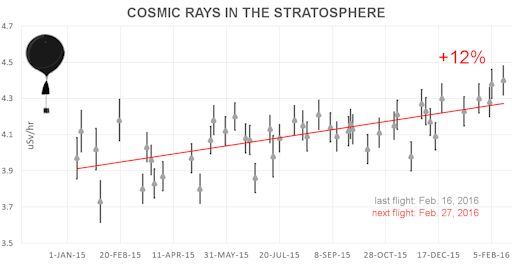
The data show that cosmic rays in the mid-latitude stratosphere now are approximately 12% stronger than they were one year ago. Cosmic rays, which are accelerated toward Earth by distant supernova explosions and other violent events, are an important form of space weather. They can seed clouds, trigger lightning, and penetrate commercial airplanes. Furthermore, there are studies linking cosmic rays with cardiac arrhythmias and sudden cardiac death in the general population. Among patients who have an implanted cardioverter - defibrillator (ICD), the aggregate number of life-saving shocks appears to be correlated with the number of cosmic rays reaching the ground. References: #1, #2, #3, #4. Why do cosmic rays increase when solar activity is low? Consider the following: To reach Earth, cosmic rays have to penetrate the inner solar system. Solar storms make this more difficult. CMEs and gusts of solar wind tend to sweep aside cosmic rays, lowering the intensity of radiation around our planet. On the other hand, when solar storms subside, cosmic rays encounter less resistance; reaching Earth is a piece of cake. Forecasters expect solar activity to drop sharply in the years ahead as the 11-year solar cycle swings toward another deep minimum. Cosmic rays are poised to increase accordingly. Our next balloon flight is scheduled for Feb. 27th. Stay tuned for updates. Bonus: Balloon flights to the stratosphere produce not only scientific data, but also beautiful imagery. A camera onboard the Feb. 16th payload took this picture from an altitude of 107,500 ft: 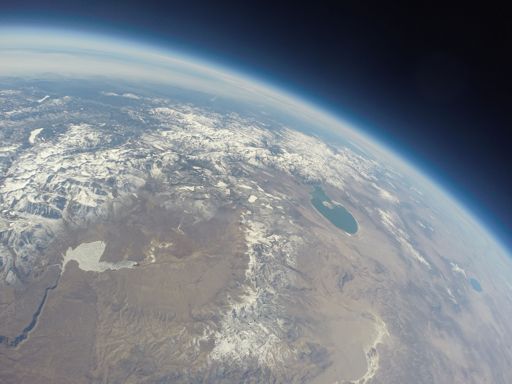
The photo frames two lakes in California's eastern Sierra mountain range. Take a closer look. Crowley Lake, on the left, is crusted with large rafts of cracked ice. Mono Lake, on the right, is liquid blue. What's the difference? Mono Lake is one of the saltiest lakes in the western USA, and that lowers its freezing point, allowing it to remain fluid even during the coldest months of winter. More high-altitude photos from our cosmic ray research may be found here. Realtime Spaceweather Photo Gallery PYRAMIDS OVER CALIFORNIA: People who pay attention to the daytime sky often notice a luminous ring surrounding the sun. It's called an ice halo, caused by sunlight shining through ice crystals in wispy cirrus clouds. On Feb. 23rd, San Francisco photographer Mila Zinkova looked up and saw not one, but "four wondrous circles around the sun." She quickly moved into the shadow of a totem pole and snapped this picture: 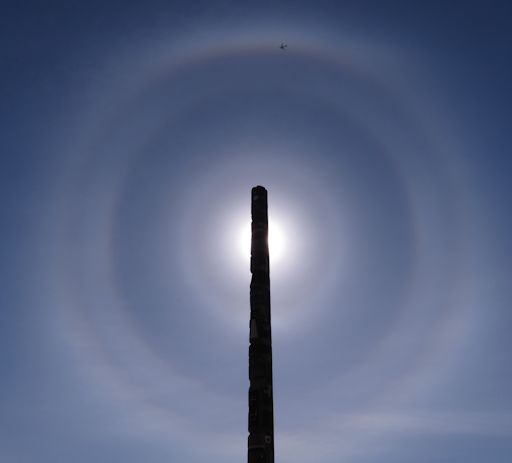
About 100 miles away in Ballico, California, Richard Sears witnessed a similar display. "I've been photographing sun halos here in California for years. I must say, this is the first," says Sears. "I wonder what is going on here?" The answer: The air was filled with tiny pyramids of ice. Atmospheric optics expert Les Cowley explains: "These are magnificent and rare displays of pyramidal crystal halos. Ordinary halos are made by six-sided column- or plate-shaped crystals in high and cold cirrus clouds. Over California their ends were capped with pyramids. The pyramids always have fixed angles set by planes of atoms in the ice. Light passing through them form 'odd radius halos' 9, 18, 20, 23, 24 and 35 degrees from the sun. On Mila's image I can see a bright 9 degree ring, an 18 degree one and then a clump of twenty-something radius halos." Realtime Spaceweather Photo Gallery
Realtime Aurora Photo Gallery
Realtime Comet Photo Gallery Every night, a network of NASA all-sky cameras scans the skies above the United States for meteoritic fireballs. Automated software maintained by NASA's Meteoroid Environment Office calculates their orbits, velocity, penetration depth in Earth's atmosphere and many other characteristics. Daily results are presented here on Spaceweather.com. On Feb. 26, 2016, the network reported 15 fireballs.
(15 sporadics) 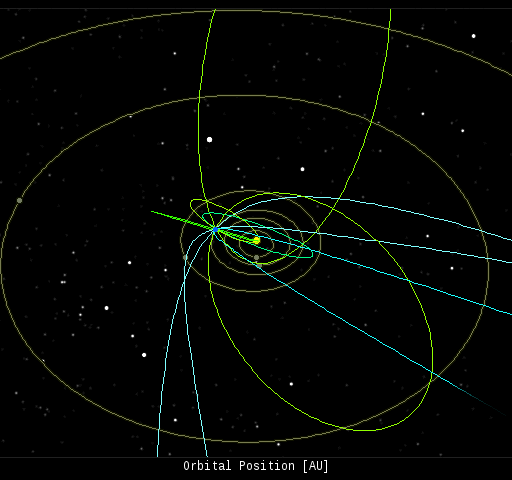 In this diagram of the inner solar system, all of the fireball orbits intersect at a single point--Earth. The orbits are color-coded by velocity, from slow (red) to fast (blue). [Larger image] [movies] Potentially Hazardous Asteroids ( PHAs) are space rocks larger than approximately 100m that can come closer to Earth than 0.05 AU. None of the known PHAs is on a collision course with our planet, although astronomers are finding new ones all the time. On February 26, 2016 there were potentially hazardous asteroids. Notes: LD means "Lunar Distance." 1 LD = 384,401 km, the distance between Earth and the Moon. 1 LD also equals 0.00256 AU. MAG is the visual magnitude of the asteroid on the date of closest approach. | | Cosmic Rays in the Atmosphere | | Situation Report -- Oct. 30, 2015 | Stratospheric Radiation (+37o N) | | Cosmic ray levels are elevated (+6.1% above the Space Age median). The trend is flat. Cosmic ray levels have increased +0% in the past month. | | Sept. 06: 4.14 uSv/hr (414 uRad/hr) | | Sept. 12: 4.09 uSv/hr (409 uRad/hr) | | Sept. 23: 4.12 uSv/hr (412 uRad/hr) | | Sept. 25: 4.16 uSv/hr (416 uRad/hr) | | Sept. 27: 4.13 uSv/hr (413 uRad/hr) | | Oct. 11: 4.02 uSv/hr (402 uRad/hr) | | Oct. 22: 4.11 uSv/hr (411 uRad/hr) | These measurements are based on regular space weather balloon flights: learn more. Approximately once a week, Spaceweather.com and the students of Earth to Sky Calculus fly "space weather balloons" to the stratosphere over California. These balloons are equipped with radiation sensors that detect cosmic rays, a surprisingly "down to Earth" form of space weather. Cosmic rays can seed clouds, trigger lightning, and penetrate commercial airplanes. Our measurements show that someone flying back and forth across the continental USA, just once, can absorb as much ionizing radiation as 2 to 5 dental X-rays. For example, here is the data from a flight on Oct. 22, 2015: 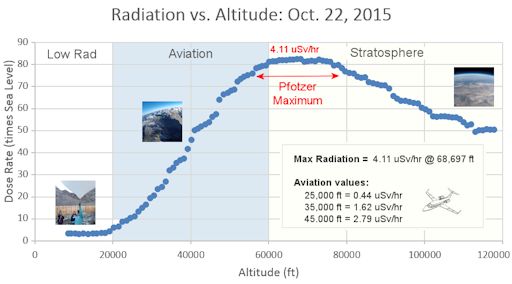
Radiation levels peak at the entrance to the stratosphere in a broad region called the "Pfotzer Maximum." This peak is named after physicist George Pfotzer who discovered it using balloons and Geiger tubes in the 1930s. Radiation levels there are more than 80x sea level. Note that the bottom of the Pfotzer Maximim is near 55,000 ft. This means that some high-flying aircraft are not far from the zone of maximum radiation. Indeed, according to the Oct 22th measurements, a plane flying at 45,000 feet is exposed to 2.79 uSv/hr. At that rate, a passenger would absorb about one dental X-ray's worth of radiation in about 5 hours. The radiation sensors onboard our helium balloons detect X-rays and gamma-rays in the energy range 10 keV to 20 MeV. These energies span the range of medical X-ray machines and airport security scanners. | | The official U.S. government space weather bureau | | | The first place to look for information about sundogs, pillars, rainbows and related phenomena. | | | Researchers call it a "Hubble for the sun." SDO is the most advanced solar observatory ever. | | | 3D views of the sun from NASA's Solar and Terrestrial Relations Observatory | | | Realtime and archival images of the Sun from SOHO. | | | from the NOAA Space Environment Center | | | the underlying science of space weather | | 
